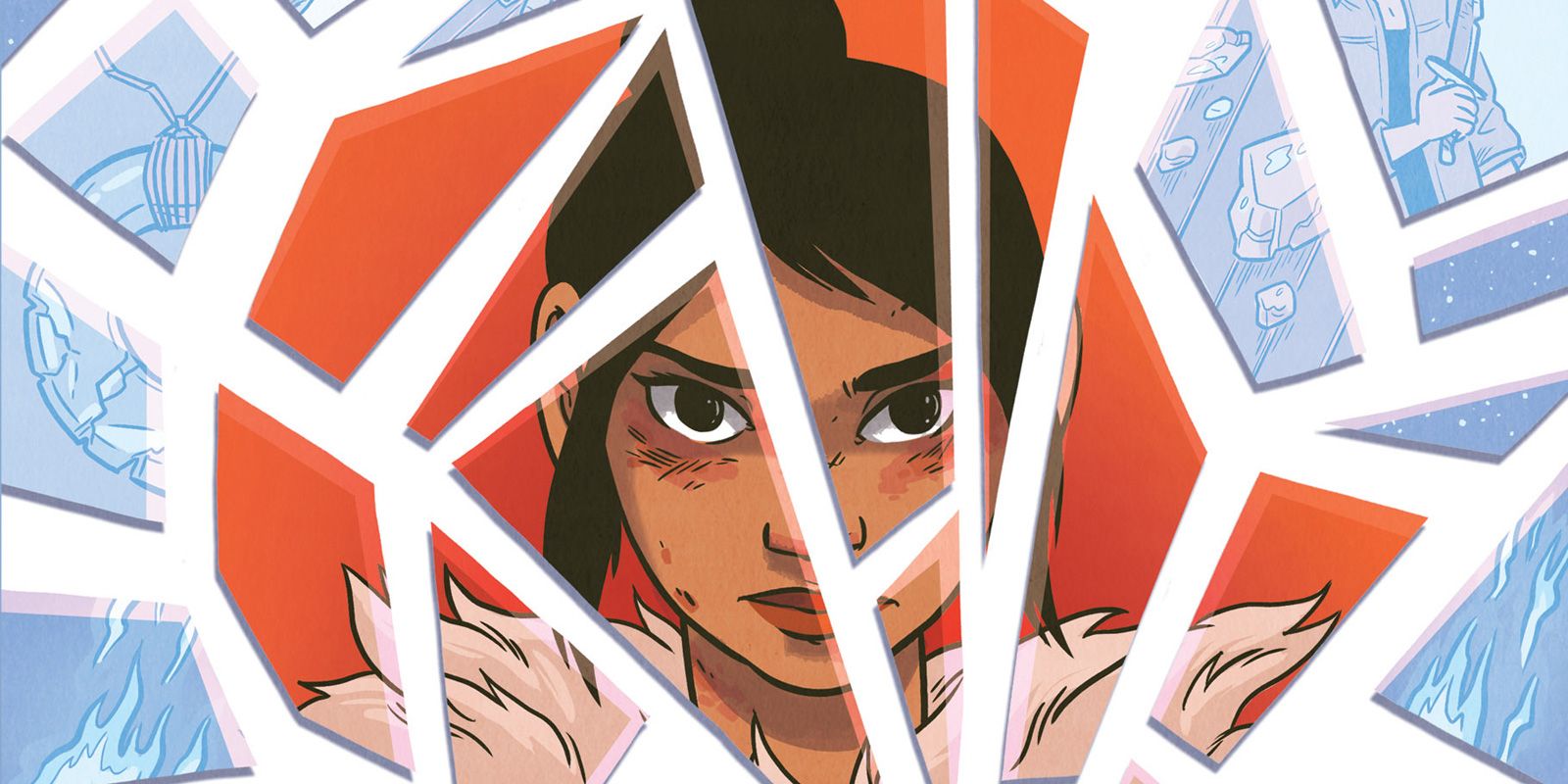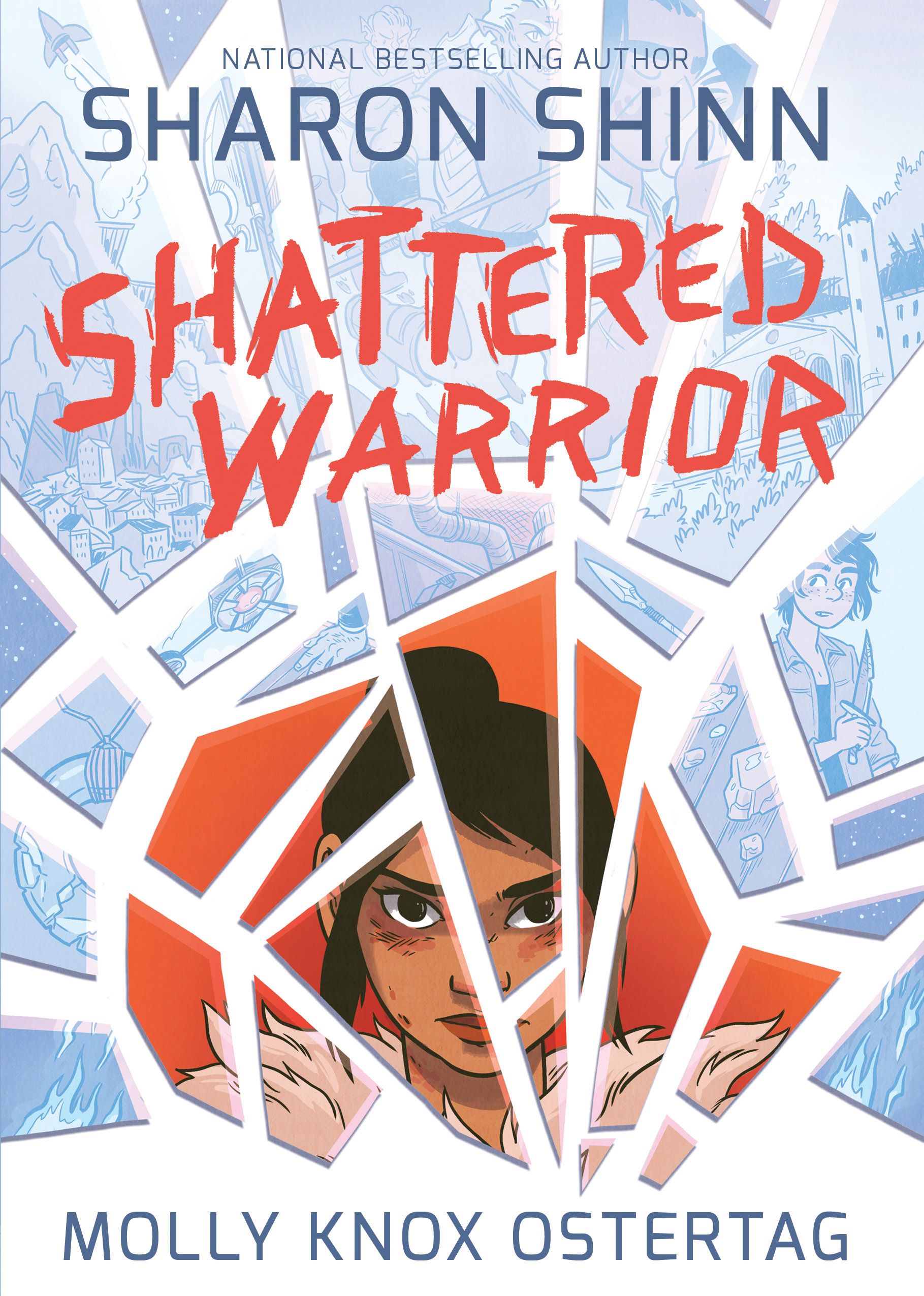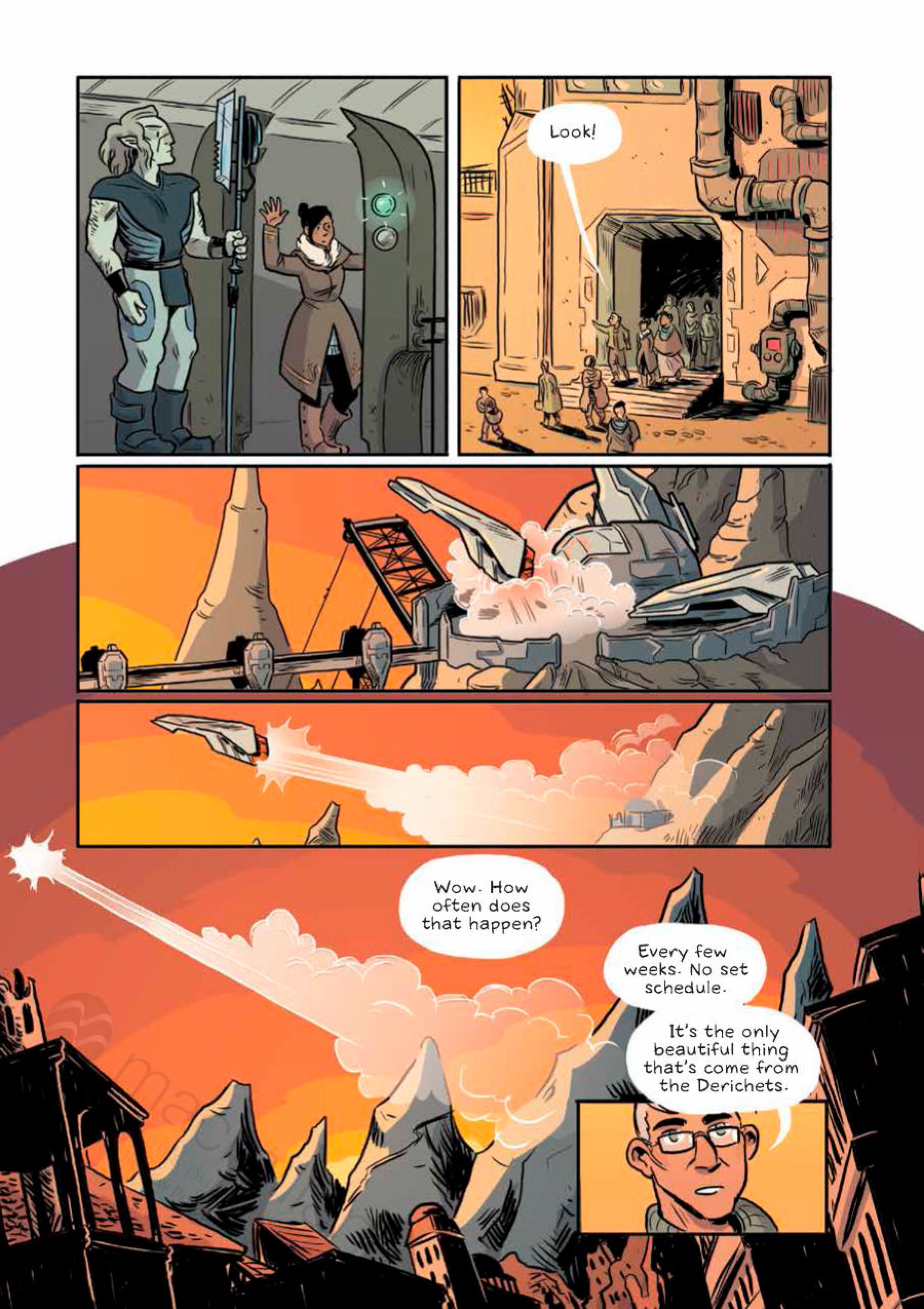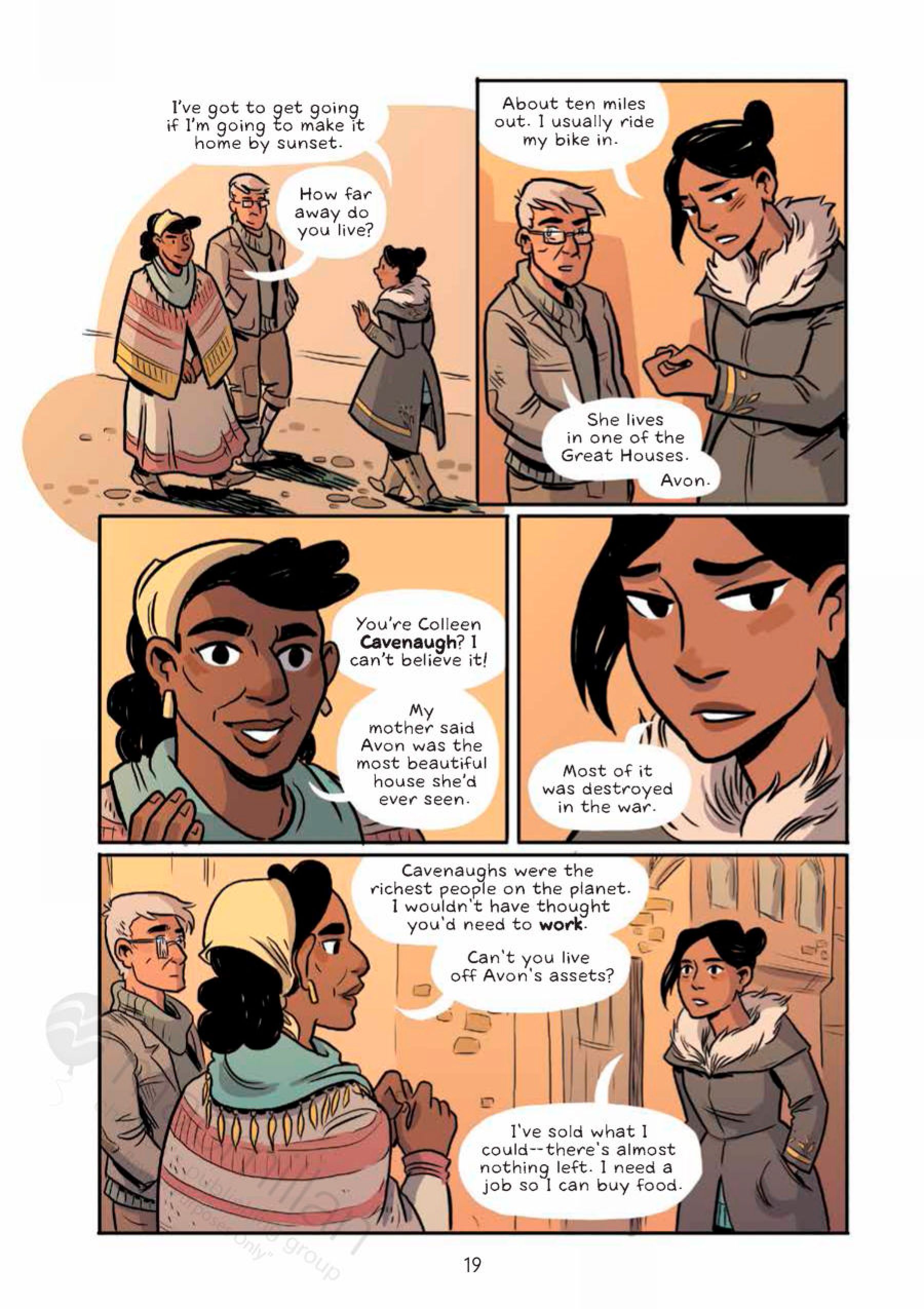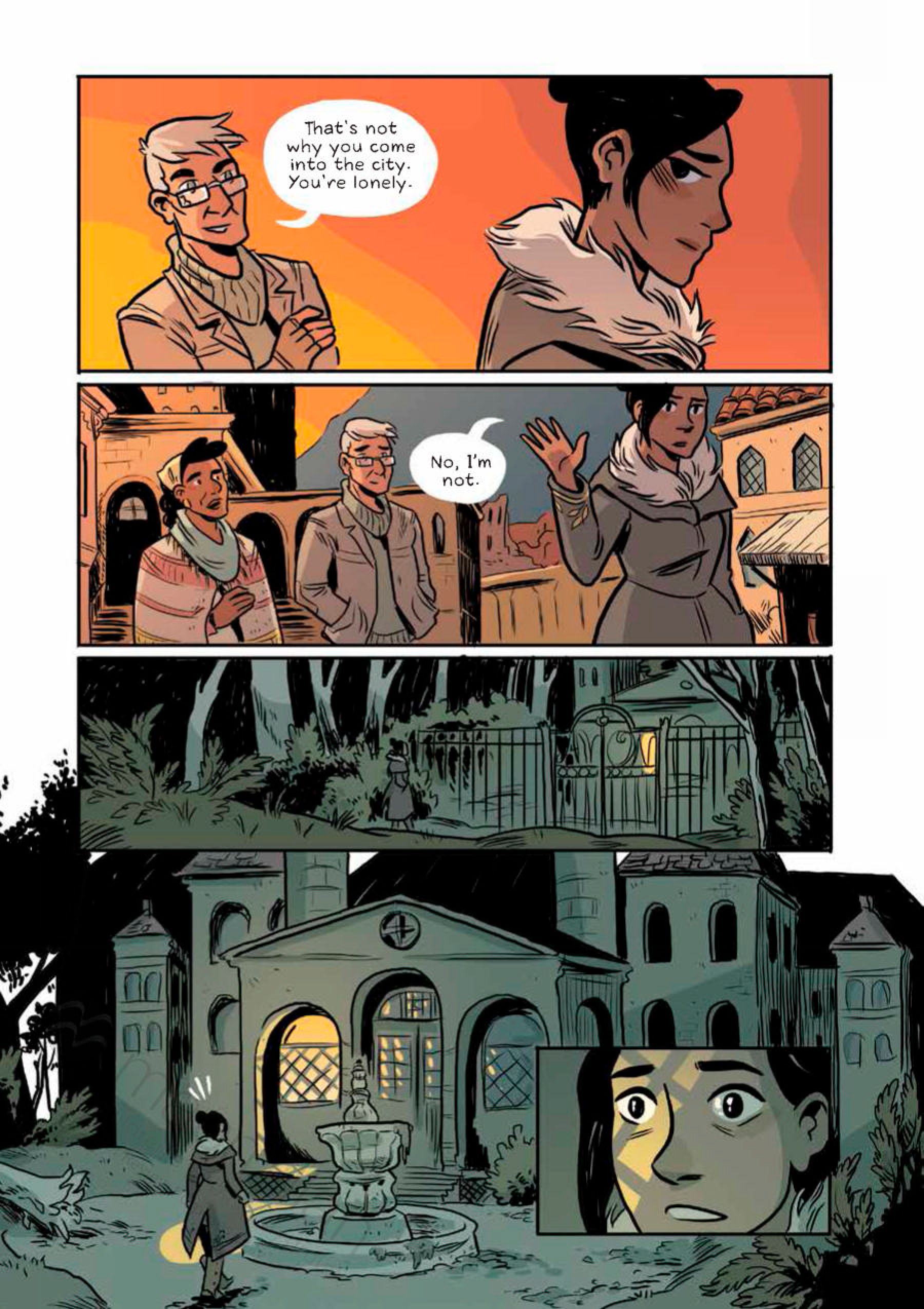They came nearly a decade ago -- the Derichets, the conquerors. Ever since then, the human population has been reduced to slave labor. They work day and night, refining the precious ore the Derichets need for their craft and weapons. As Colleen sees it, there is no reason to ever bother with hope. She’s lost her family, her status, everything. There is only the tedium of the task in front of her.
Then she meets Jann, a member of the lower-caste Chromatti in the pre-Derichet days, and Jann has different ideas about loss. More importantly, he, along with Colleen’s new coworkers at the refinery, has different ideas about what is left to live for in the post-Derichet world.
Colleen’s unfolding place, emotionally and in the human uprising, is the heart of the sci-fi adventure unfolding in Shattered Warrior, a graphic novel from First Second Books, in stores now. Written by celebrated author Sharon Shinn, making her comics writing debut, and illustrated by Molly Knox Ostertag of the webcomic Strong Female Protagonist, is a fast-moving adventure story with a deep, unfolding tale of human connection at its core. With over two dozen novels, including the Samaria and Twelve Houses series, to her credit, Shinn reveals rarely mined emotional layers to the timeless struggle against alien oppressors saga.
RELATED: Mulligan & Ostertag’s “Strong Female Protagonist” Conquers All
CBR talked to Shinn and Ostertag (who earlier this year ran a successful Kickstarter campaign to fund the second book of Strong Female Protagonist) about adding emotional depths to classic story motifs, the delay in gratification when you’re used to producing a twice-weekly webcomic, and learning to truly embrace the potential of the comics format.
CBR: Sharon, Molly, where is Colleen when Shattered Warrior begins?
Sharon Shinn: Colleen’s just in basic survival mode. She’s lost everyone and everything she ever loved, and she’s trying to make it through each day with no new damage. She’s developed a sense of equilibrium and she wants to keep it -- she doesn’t want to care too much about anything ever again because she’s afraid she can’t deal with one more loss.
A ragtag group of humans against overwhelming alien odds isn’t new, but you give tremendous emotional depth to Colleen’s story in Shattered Warrior. The thrust of her loss and her shunning human connections could work in literally any setting. What put this scenario together with her emotional journey?
Shinn: A ragtag group fighting against great odds is a pretty classic tale, but I think it’s a story we keep telling because it always brings about a sense of renewed hope! I don’t think Colleen would ever have joined the rebels if she hadn’t taken that emotional journey -- if Jann and Lucy hadn’t entered her life -- if she hadn’t come to realize that some things are worth fighting for even if the costs are astronomical. So for me, the story of Colleen’s reawakening and the story of the rebel uprising are inextricably intertwined.
Molly Ostertag: As a reader and a creator, I’m only interested in stories with a strong emotional core. The most original setting can only be so interesting without showing how it emotionally impacts the people existing in it. Colleen’s story and the depth of her loss is tied directly to the loss of her world.
How long ago did the Derichets conquer the humans? We really only meet two of them - cruel Korso and tolerant Agnit, but suffice to say that the Derichet population in general is closer to Korso in their view of humans?
Shinn: The Derichets arrived eight years before the story begins. Yes, generally speaking, the Derichets are more like Korso -- they see the humans as just another inferior race to be conquered, just more faceless workers to send down to the mines. I imagine that they’re equally dismissive of the people on the other planets they’ve invaded. But Angit’s presence in the story shows that, even among the villains, there is some variation, some depth, and some emotion.
What formed the basis for Jann’s tribe, the Chromatti? They seem to reflect a very stratified class- or caste-based culture prior to the arrival of the Derichets.
Shinn: Right, the society here was strictly segregated before the Derichets landed. That was one way I could present a sort of cultural backstory to show that the people here had distinct patterns of life that were drastically changed after the war. Before the invasion, the Chromatti were children of the miners, part of the poorest and most disadvantaged population. They were used to poverty and hunger and violence, so in some sense, they were better equipped to function in a world ruined by invasion. By contrast, the wealthier people weren’t used to hard labor; they didn’t have that single-minded focus on survival. I think fewer of them made it out of war alive.
Sharon, after writing close to 30 novels and dozens of short stories, what prompted the move to comics?
Shinn: I just got lucky. An editor from First Second had read some of my books and liked my style; he invited me to write a graphic novel. I said, “Well, I’ve never done that before, but it sounds like fun.”
How was the learning curve for writing a comics script? Not only is the book very good, but you also pull off some challenging storytelling choices, such as two long, entirely silent sequences. Some writers are hesitant to give up their words on the page, but you dove right in.
Shinn: It was a steep learning curve, but I knew it would be! First, I read a bunch of recent graphic novels, including a companion book to one of them that showed how the script had been written and broken down into panels (though I didn’t write my script that way). Then I completed several drafts of the script, making changes as my editor suggested to tighten dialogue or heighten suspense. I worked on a final draft with Molly as she found ways to condense some scenes and rework others so they would have more dramatic impact in a visual form.
One thing that was clear to me from the beginning was that it was important to let the art tell some of the story. In some of the graphic novels I read—including Sara Varon’s Robot Dreams and Shaun Tan’s The Arrival—there are no words at all. I love words too much to ever completely give them up, but I wanted to try to create at least a few scenes where there was no dialogue, just art. And I must say, those are some of my favorite scenes in the whole book.
Molly, your webcomic Strong Female Protagonist has been ongoing for five years and hundreds of pages, but you have a twice-weekly publishing schedule to garner feedback for each page as it’s completed. How does that compare to a project like this, drawing 250 pages for one release?
Ostertag: It’s a little agonizing, honestly! Strong Female Protagonist was how I taught myself how to make comics and my first long-form project. That instant feedback is addicting -- you get to see your readers’ thoughts as the story is developing, to make small tweaks in tone and in what you decide to highlight. However, it can be daunting and stressful at times, especially in scenes that need to be read fully to understand -- you pray that your readers will stick with you until the end and that it will have the payoff you hope. So, creating this book was a much more peaceful process!
What else do you each have coming up?
Shinn: I’m working on another book that might be part of a trilogy, but I’m in the early stages yet so it’s too soon to talk about!
Ostertag: I have a book coming out from Scholastic this November! It’s called The Witch Boy and it’s the first book I both wrote and drew, and I’m really excited about it.
Shattered Warrior is in stores now from First Second Books.

